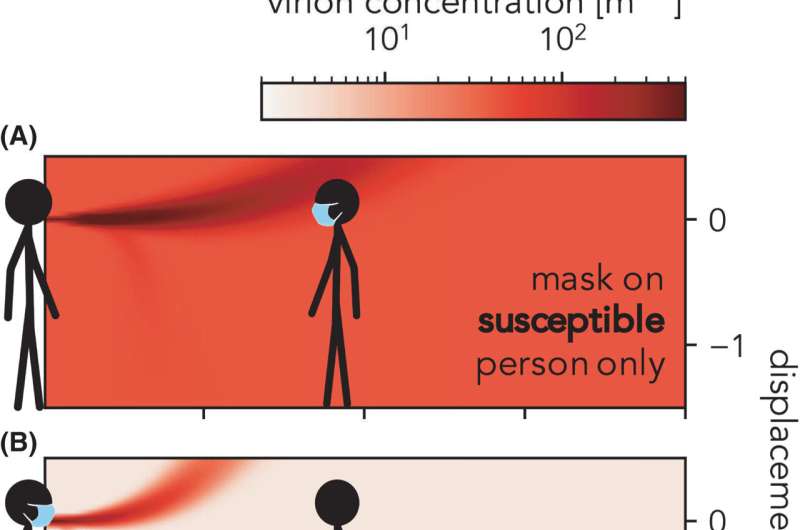Layered controls can significantly curb exposure to COVID-19

As the COVID-19 pandemic unfolded, a team at the U.S. Department of Energy's (DOE) Brookhaven National Laboratory set out to better understand how well face masks, ventilation, and physical distancing can cut down transmission of airborne pathogens like SARS-CoV-2, the virus that causes COVID-19.
Using a new computational model that simulates the life cycle of pathogen-laden particles, the researchers found that a combination of distancing of six feet, universal mask-wearing, and increased room ventilation could reduce the risk of infection by more than 98% in more than 95% of scenarios studied.
"Wide adoption of layered controls dramatically reduces exposure to existing airborne viruses, such as SARS-CoV-2, and will be critical to control outbreaks of novel airborne viruses in the future," said Laura Fierce, an atmospheric scientist formerly with Brookhaven Lab, now at DOE's Pacific Northwest National Laboratory. "These nonpharmaceutical interventions can be applied in combination with vaccinations."
The study is published in the journal Indoor Air. It focuses on how face masks and ventilation work alone and in combination with distancing to reduce the likelihood of someone inhaling virus-laden aerosol particles in particular scenarios—namely, where an infectious person is speaking continuously in an indoor space for three-hours—while also accounting for uncertainty in factors governing airborne transmission.
Fierce collaborated with Alison Robey and Catherine Hamilton—who were participants in the DOE's Science Undergraduate Laboratory Internships (SULI) program at Brookhaven— to develop the model of respiratory aerosols and droplets used in the study. The model simulates how virus-laden particles move through the jet of air expelled by an infectious person and within the larger indoor space. It considers how expelled particles change in size as water evaporates, how pathogens within those particles become inactive, and how particles are removed through ventilation, deposition on surfaces, and gravitational settling.
The researchers' simulations showed that exposure to airborne pathogens is significantly lowered by individual controls, such as face masks. But layering controls—that is, using them in combination—can be even more effective. According to the study, the combination of universal mask-wearing and distancing of even just three feet reduced a susceptible person's risk of infection by 99 percent. On the other hand, without the use of face masks, distancing of at least six feet was needed to avoid increased exposure to respiratory pathogens near an infectious person. The team also showed that increasing ventilation rates by completely replacing the air in a room with fresh or filtered air four times per hour reduces the risk of transmission by more than 70 percent, so long as the infectious person and susceptible person are distanced by at least six feet. On the other hand, ventilation does little to reduce the risk of infection when the infectious person is close by.
"Our detailed modeling of respiratory particles shows how different controls on airborne transmission work in combination, which is important for prioritizing mitigation strategies for different indoor spaces," Fierce said.
More information: Laura Fierce et al, High efficacy of layered controls for reducing exposure to airborne pathogens, Indoor Air (2022). DOI: 10.1111/ina.12989



















